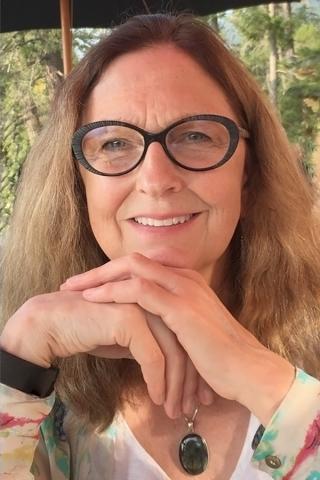Photo: Linda Craddock. Photo credit: Carole Couchman.
BACHELOR OF FINE ART IN FIBRE AND METALS, 1974
ALUMNI DISCOVERY INITIATIVE, INTERVIEW BY JOANNE FISHER, 2015
UPDATED ON MAY 10, 2019
Joanne FISHER: What was your first year at ACAD like? Where did you go from there?
Linda CRADDOCK: I started in 1970. The first year was a foundation year and there were eighty of us, which was significantly more than previous years.
We weren't housed in a physical building, yet. We had a drawing class in a rifle range — our classes were mostly in the electronics building. Everyone took the same classes in first year, even those planning on doing the advertising diploma. Advertising Art was the big winner then. That was the only discipline where you were guaranteed to make any money, so I lied to my parents saying I was going into Advertising Art, knowing I had no interest in it.
In our second year, we were divided up into the various disciplines. When interviewed, I said, very shyly that I wanted to be a painter, but the instructor put me in "Fibre and Metals" instead. I just did what I was told. I was nineteen and didn’t have the confidence to argue, so I ended up there for the next three years.
By my last year, we had moved into the new building: the Alberta College of Art (ACA). As I recall, that year, they brought in 500 new students — I could be wrong on those numbers — to fill the building.
By that time, I was weaving, taught by Doug Motter. I visited [AUA] recently and I saw that the fibre department is using the same looms that I had worked on back then. They were new when I was in school; I actually assembled some of those [looms] during my final post-grad year in 1975.
ACAD’s foundation year was such strong, intensive training in those days, and our instructors were mostly grads from the earlier years of [ACAD]. I have a list of those teachers, the old guard of Calgary art. Many of them are dead and gone: Ken Sturdy, Frank Vervoort, Stan Blodgett, Walter Drohan, Ole Olafson. Stan Perrott was the head of the college at that time. John Hall taught us design that first year. Also Brian Nemish, Bruce O'Neil...
The ACA had a good program. I guess it was based on formalist theory at that time so we had a very strong design program and I think that carried me through my whole life. I think that foundation year was the best thing that happened to me at ACA. The following years were good, too. I did succeed. I recently found my CV from 1976… I'd had shows everywhere in Alberta, and work that was purchased by the AFA. I was exhibiting these woven sculptural forms.
When I left around 1975 — I was married by then — and was able to work in a home studio, and raise a family. I had built these woven sculptures for a solo exhibition at the University of Calgary (U of C) so that was a bit of work but I eventually became bored with myself — I wanted more education.
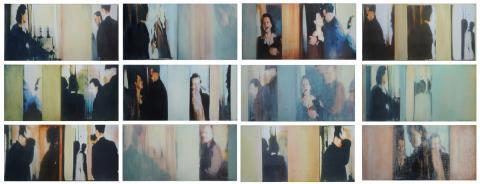
Embarkation, 1945, 10 x 84", mixed media, oil on birch
At ACA, we'd studied a little bit of English literature; really only a miniscule amount. I think we were given one novel to read. Was it Jack Kerouac's On The Road? Art History was also minimal: an overview of everything from the old Jenson History of Art book that you find in every used bookstore in Calgary. So, I signed up at the U of C Fine Arts Program and I ended up being really happy with that decision. By then I was 24, and I only knew how to draw. I needed more, so I sought a different kind of education. In that first year I took History of Modern Art, some education-based communication courses, drama, sociology, psychology, critical inquiry, the novel and short story…I took a full course load all while having one, and then two, children at home to juggle.
I went into fine arts at the U of C with such a strong practical art-making knowledge-base from ACA. I recall that at ACA we worked full days in studio. In comparison, the U of C’s studio classes were only three hours long. It was quite different. I used my knowledge of design from ACA to get right into what I still do now, which is mixed media photography and painting.
I graduated from U of C with a BFA in 1982 and went into their MFA program in 1986. They offered me a spot in straight photography, but wouldn’t accept my mixed media practice. So, I did my MFA using straight photography, film of course. Black & white and Cibachrome. After I graduated, I sold my Hasselblad camera, moved to the west coast and started writing. I got involved with the local writer’s groups before getting into painting in 1999. I did a lot of colour studies, colour theory before putting my work out there. By 2003, I moved back to Calgary. I wanted to be more involved in the arts community. I'd lived on Pender Island, in the middle of nowhere for those last 7 years, just working quietly. Although I was represented by galleries in Calgary and Victoria at the time, I was physically isolated. I did like that experience, though, and I needed it to initially study my discipline and replace the voices of the past, of others with my own.
FISHER: You’ve had quite an evolution in your work. You started in textiles, which sounds like maybe that wasn’t the greatest fit for you.
CRADDOCK: Well, I took it as far as I could. I would start on a 12-harness loom and do interlaced layers that opened into sculpture. The next thing I envisioned was more environmental in size, and I thought that ungainly, when I could simply just take a photograph or draw something. Ultimately, I wasn’t a 3D person!
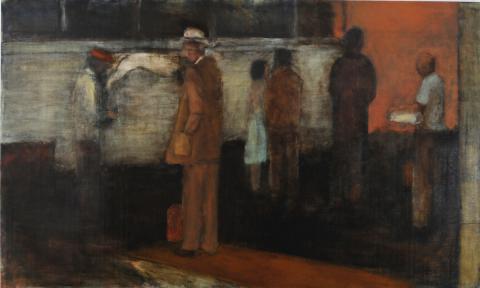
Levitas: Greyhound Banff Station, 36 x 60", oil on birch
FISHER: I am curious about your insights that came with the need to move on.
CRADDOCK: I’d say that the "thread" I’ve followed is the need to create, communicate essentially autobiographical work. That’s what has carried me through, whether I try one medium or another. Straight photography didn’t really do it for me though the work was collected by the Canadian Museum of Contemporary Photography and The Edmonton Art Gallery. Doing mixed-media photography worked for me because I could then comment in a very personal way about what was going on for me in the 1950's on throughout my life, and question my relationship with the lives of the generations before mine. I've done loads of autobiographical artworks and I’m still mining memories: attitudes, limitations through photographic imagery.
FISHER: In your online portfolio, I saw your combination of photography and painting. It seems very personal with the blurriness and the transition of states.
CRADDOCK: Yes, the more abstract work is in fact called Transitions. I move in and out of that as well. There are smaller ones in the studio that are about movement and change, but psychologically represent states of mind. The series Hometown Dreams carries that transitional form, but the image shifts, floats and blurs. My more recent work Levitas explores dreams and changing memory. It's about transcending the bounds of gravity and of spiritual aspiration. I bring in ghosts of my family.
FISHER: You’ve been quite prolific.
CRADDOCK: I haven’t had to deal with balancing another kind of career. I’ve been able to focus on my work and that’s been a real gift. When I moved back to Calgary, for extra money and to be involved with community, I worked with artist residency programs through AFA (Alberta Foundation for the Arts) and the Calgary Board of Education. I taught at U of C and in Continuing Education
FISHER: So, your work has evolved through the need to express yourself in certain ways or you find the way to express it?
CRADDOCK: I find a way to express it. I've written a play! And taken several courses to learn how to write a play. Creativity is necessary for my psychic health. I have gone for periods of time where I didn’t work at all. If I’m without creative expression for a period of time, I feel lost. I’ve had a life where I’ve had a lot of different things happen – a lot of moving, more than a couple of marriages, and two generations of offspring. There have been difficult times but I have my creative work and I can’t not do it. It’s a drive. It doesn’t matter to me if anyone looks at it. It’s a personal need to communicate from a very deep place.
Showing your work publicly demands marketing and that’s a very different activity than doing the work. I can work for a long period, a year or two, and not care if anyone sees it. When I returned to painting in 1999, I didn’t want any interference. I went out of my way to make sure no-one knew that I was painting, but when we do that kind of activity people are attracted to it and find it almost by accident.
That work was taken into galleries quite easily after some time alone and I just kind of went with that, but for me, it’s more about making art -getting the actual work done. On the other hand, I’m not so introverted because there is a part of me that will market. That’s the other side. Ultimately, I have had to do both to make some money and /or impact on the community.
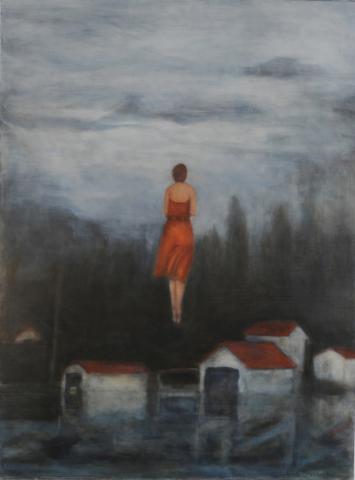
Levitas: Evening, Bow River Boathouse, 48" x 36", oil on birch
FISHER: What insights and advice do you have for art students?
CRADDOCK: It’s not a career that’s going to provide income, so it has to be your passion. You might teach and do more graphic or commercial art, but art definitely is a passion. That’s the first criteria. Of that initial student body of 80, maybe 15% of my ACA graduating class are making art now, and the majority of these majored in advertising art!
Art history should be a priority for anyone who wants to be an artist because then you have something to work from, and you aren’t reinventing the wheel. That’s important. Make sure to study other things that are interesting to you, not just art. Having another way to inform one’s art practice is important. That’s one of the things that going to [the] university [of Calgary] did for me. Just get a well-rounded education so you’re not going down this one narrow road because sometimes, as life goes on, you will need to know something else, or find employment! Have some experience in something else – maybe get a second degree.
Back in the day, there were a lot of artists who had day jobs — the well-known printmaker and painter John Snow worked in a bank. People have to work — not everyone has the luxury of focusing solely on their art.
Volunteer. I'm involved in the KOAC (Kyooka Ohe Arts Centre) and am at the moment, President of the Alberta Society of Artists. I do my part in helping put art into the community and encouraging emerging artists. I believe that as a community of artists, we can help each other. I've always believed that there is room for, a place for everyone.
FISHER: What advice do you have for setting up a creative business?
CRADDOCK: We’re pushing so many kids through post-secondary and they’re all looking for work. The institution becomes a business in itself — cranking out artists. Nothing means as much with so many out there because there is so much competition for curatorial jobs or even working in an office for an organization that has to do with the arts. Some artists teach - in whatever capacity they can.
Some people say to keep your art distinct from what you do as a living — to keep it clean.
FISHER: How do you think creativity fits into the big picture?
CRADDOCK: It’s a way of viewing the world and taking in all of that random information. My whole world is about creativity, every day. That’s a difficult one. How to bring creativity to the world — is that what you are asking?
FISHER: I think it’s more how do you see its importance in the world and the importance of your work in the world? It’s a very big question.
CRADDOCK: My art practice is my form of communication, my autobiographical work a form of inner communication. It’s a query. It’s a way to understand my own reality and to connect my experience with other people’s, for example when they see some image that I’ve used in my work and there is flash of ‘I know that.’ My work is a form of communication.
In education, creativity is so important. When I’m teaching, I’m showing students how to see the world differently. To give them tools and to acknowledge that I understand what they are communicating through their work. That flash of recognition in another human being. That communication is big for me.
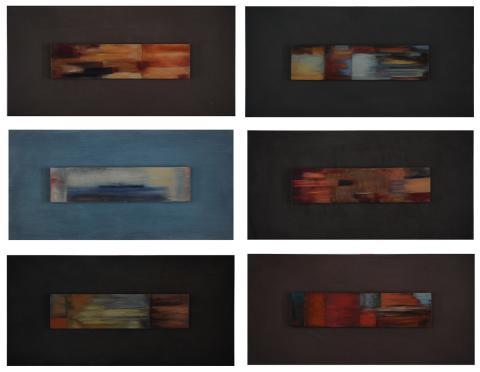
Transitions Series, 12 x 24" each, mixed media, oil on board
FISHER: How do you envision ACAD supporting alumni?
CRADDOCK: Exhibition opportunities. That’s always needed; a public venue. There are fewer venues available and more artists. Have several exhibitions – not one every 10 years.
And for the younger grads, group shows. There used to be more opportunities for artists in the 1980s and 1990s than there are now. Prepare recent graduates by showing them how to come together and create their own exhibition venues. Whatever it takes. Renting space. Granting agencies! Give more guidance for students interested in doing that. Give them something to consider that will help bring them closer to being a professional artist. The energy dissipates when the student leaves school and falls into work and loan payback.
I was going to say some sort of convention for grads. I don’t know what it would look like. I want to know what skills are coming out of ACAD, what they are doing with their abilities, and how they’ve made their degree work for them professionally.
FISHER: What would you like to be recognized for?
CRADDOCK: Artistically? My painting – without question. That’s been my major focus. I think it’s always been a harder road to be focused on autobiographical work because it doesn't follow a trend — the work comes from a strong internal place that attracts a particular clientele and gallery. But it's authentic and that’s what I’ve had to go with because that's who I am.
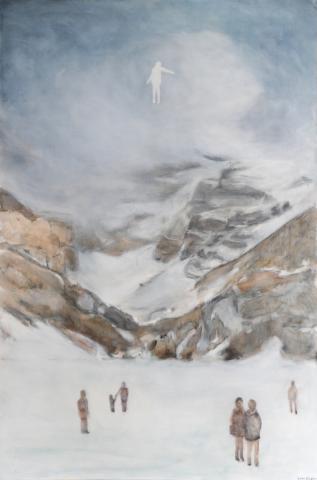
Levitas: Lake Louise Winter, Self Portrait, 60 x 40", oil on birch
